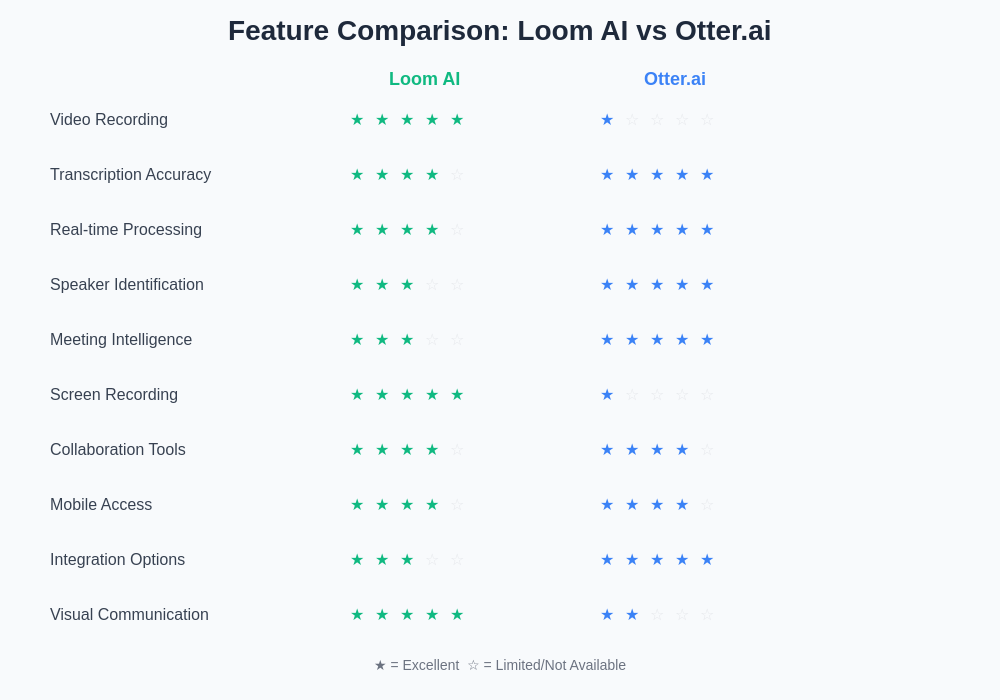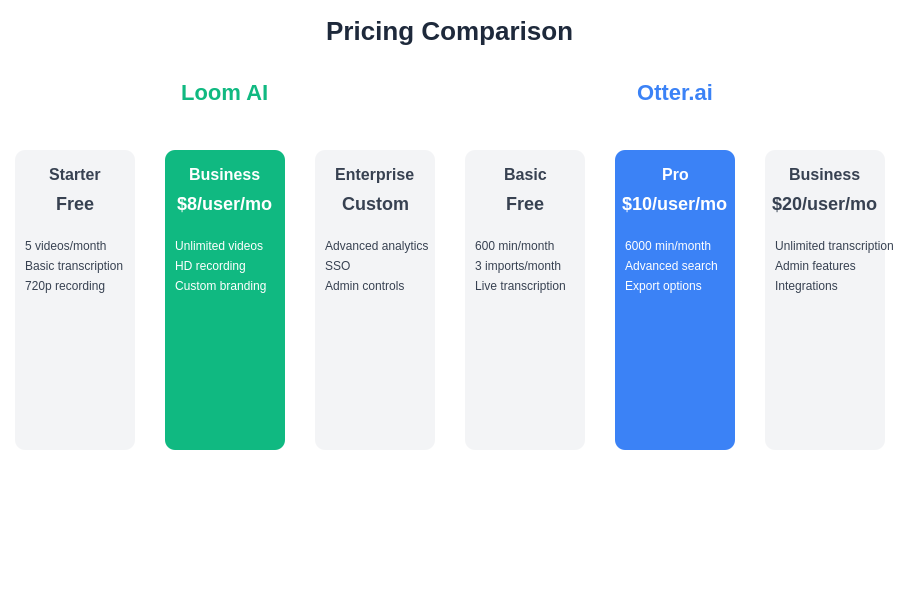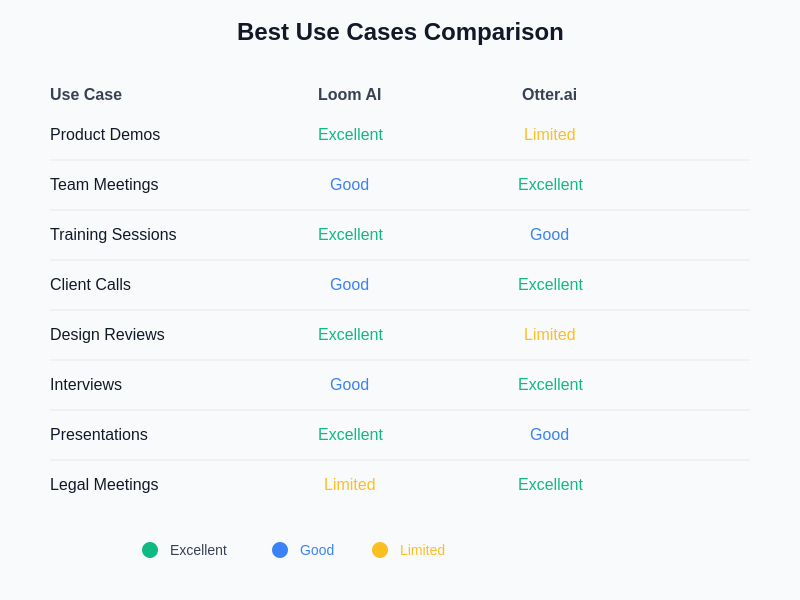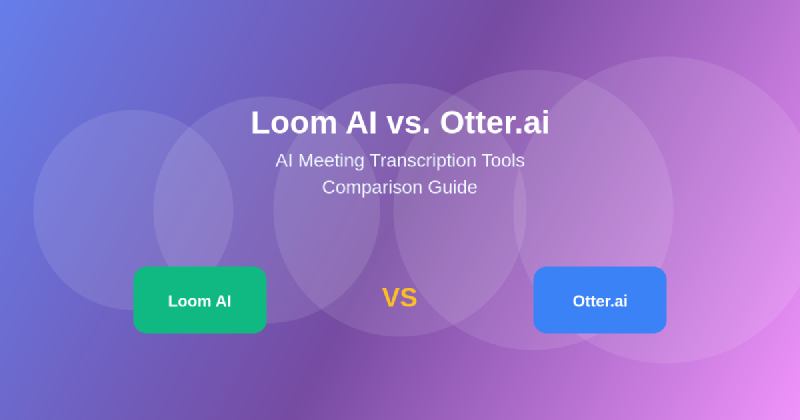The digital workplace has fundamentally transformed how teams communicate and collaborate, creating an unprecedented demand for sophisticated meeting transcription and recording solutions that can seamlessly capture, organize, and analyze verbal communication across various professional contexts. In this evolving landscape, two prominent artificial intelligence-powered platforms have emerged as leading contenders for meeting transcription excellence: Loom AI and Otter.ai, each offering distinct approaches to solving the complex challenge of converting spoken conversations into actionable, searchable, and shareable digital content.
Stay updated with the latest AI tool developments to discover cutting-edge solutions that are revolutionizing workplace productivity and communication efficiency. The comparison between these two platforms represents more than a simple feature-by-feature analysis; it illuminates the fundamental differences in philosophy, target audience, and technological approach that define the current state of AI-powered meeting assistance tools.
Understanding the Core Platforms
Loom AI and Otter.ai represent two distinctly different approaches to solving the modern workplace’s communication and documentation challenges, each having evolved from unique origins and maintaining distinct philosophical approaches to user experience and feature development. Loom AI emerged from the video messaging and screen recording space, building upon a foundation of visual communication tools to incorporate advanced transcription capabilities that complement its primary video-centric functionality. This heritage influences every aspect of Loom AI’s design philosophy, creating an integrated ecosystem where transcription serves as one component of a broader visual communication strategy.
Otter.ai, conversely, was purpose-built from inception as a dedicated transcription and meeting intelligence platform, focusing exclusively on converting spoken language into accurate, searchable, and actionable text-based content. This specialized approach has allowed Otter.ai to develop deep expertise in natural language processing, speaker identification, and conversation analysis, resulting in a platform that excels specifically in the nuanced challenges of meeting transcription and audio content management.
The fundamental distinction between these platforms extends beyond mere feature sets to encompass different visions of how teams should capture, process, and utilize meeting content in their daily workflows. Loom AI envisions a world where visual and textual content seamlessly integrate to create comprehensive communication records, while Otter.ai focuses on maximizing the value extracted from purely audio-based interactions through sophisticated analysis and organization capabilities.

This comprehensive feature analysis reveals the distinct strengths and focus areas of each platform, highlighting how Loom AI excels in visual communication aspects while Otter.ai demonstrates superior capabilities in pure transcription and meeting intelligence features.
Transcription Accuracy and Language Processing
The cornerstone of any meeting transcription platform lies in its ability to accurately convert spoken language into written text, accounting for variables such as speaker accents, background noise, technical terminology, and conversational dynamics that characterize real-world business communications. Loom AI leverages advanced speech recognition technology that has been specifically optimized for video-integrated environments, where visual context can provide additional cues for improving transcription accuracy through lip-reading algorithms and contextual visual information processing.
Otter.ai has invested heavily in developing proprietary machine learning models that excel at parsing complex conversational structures, handling multiple speakers simultaneously, and maintaining accuracy even in challenging audio environments with overlapping speech or significant background noise. The platform’s specialized focus on transcription has enabled the development of sophisticated algorithms that can distinguish between different speakers, identify technical jargon across various industries, and maintain contextual understanding throughout lengthy meetings or presentations.
Enhance your AI toolkit with Claude’s advanced language processing capabilities for comprehensive text analysis and content generation that complements transcription workflows. Both platforms continuously improve their accuracy through machine learning feedback loops, but their approaches differ significantly in how they prioritize different aspects of transcription quality and user experience.
The practical implications of these technological differences become apparent in real-world usage scenarios, where Loom AI’s integration with visual content can help disambiguate unclear audio segments by referencing on-screen information, while Otter.ai’s dedicated audio processing capabilities excel in purely conversational environments where visual cues are unavailable or irrelevant to the transcription process.
Integration Capabilities and Ecosystem Compatibility
Modern workplace productivity depends heavily on seamless integration between different tools and platforms, making ecosystem compatibility a critical factor in selecting meeting transcription solutions that will effectively serve diverse organizational needs and existing technology stacks. Loom AI’s integration philosophy centers around visual communication workflows, offering robust connections with video conferencing platforms, screen sharing applications, and presentation tools that align with its core video messaging functionality.
The platform excels in scenarios where meeting transcription needs to be combined with visual elements such as screen recordings, slide presentations, or demonstration videos, creating comprehensive meeting records that capture both verbal discussions and visual context within a unified interface. This approach particularly benefits teams engaged in product demonstrations, training sessions, or collaborative design reviews where visual elements play crucial roles in communication effectiveness.
Otter.ai has developed extensive integration capabilities with major meeting platforms including Zoom, Microsoft Teams, Google Meet, and numerous other conferencing solutions, positioning itself as a universal transcription layer that can enhance virtually any audio-based communication tool. The platform’s API-first approach enables custom integrations and workflow automations that can seamlessly incorporate transcription capabilities into existing business processes without requiring significant infrastructure changes.
These integration philosophies reflect fundamentally different approaches to workplace tool adoption, where Loom AI encourages organizations to embrace integrated visual communication workflows, while Otter.ai focuses on enhancing existing meeting habits with powerful transcription capabilities that require minimal workflow disruption.
Real-Time Processing and Live Transcription Features
The ability to provide accurate, real-time transcription during live meetings represents one of the most technically challenging aspects of modern meeting transcription platforms, requiring sophisticated processing capabilities that can handle streaming audio, provide instant feedback, and maintain accuracy under the time constraints of live conversation dynamics. Loom AI’s real-time capabilities are optimized for scenarios where transcription accompanies video recording or screen sharing, providing synchronized text that enhances the overall viewing and review experience.
The platform’s approach to live transcription emphasizes integration with visual elements, allowing participants to see transcribed text alongside recorded video content in real-time, creating immersive meeting experiences that combine multiple communication modalities. This synchronized approach proves particularly valuable for remote team members who may benefit from both auditory and visual confirmation of meeting content, especially in environments with varying audio quality or language proficiency levels.
Otter.ai has established itself as a leader in real-time meeting transcription through dedicated focus on low-latency processing and high-accuracy live text generation that can keep pace with natural conversation speeds. The platform’s real-time capabilities include advanced features such as live speaker identification, instant keyword highlighting, and collaborative note-taking that allows multiple participants to simultaneously add comments and annotations to the developing transcript.
Explore Perplexity’s research capabilities to enhance your meeting preparation and follow-up analysis with comprehensive information gathering and synthesis. The technical architecture supporting these real-time capabilities differs significantly between platforms, with Loom AI prioritizing integration with video streams and visual elements, while Otter.ai focuses exclusively on optimizing audio processing speed and accuracy for purely conversational content.
Collaboration Features and Team Workflow Integration
Effective meeting transcription extends far beyond simple speech-to-text conversion to encompass comprehensive collaboration features that enable teams to extract maximum value from recorded conversations through shared access, collaborative editing, and integrated workflow management. Loom AI’s collaboration philosophy centers around visual sharing and commenting systems that allow team members to interact with both video and transcribed content through timestamped comments, shared viewing sessions, and integrated feedback mechanisms.
The platform’s approach to collaboration recognizes that meeting content often requires visual context for effective team collaboration, providing tools that enable participants to reference specific moments in both video and transcript simultaneously. This dual-mode collaboration proves particularly effective for design reviews, product demonstrations, and training sessions where visual elements significantly impact the meaning and utility of spoken content.
Otter.ai has developed sophisticated collaboration features specifically designed for text-based meeting content, including shared transcript editing, collaborative highlighting systems, action item extraction, and integrated task management capabilities that transform raw meeting transcriptions into actionable team deliverables. The platform’s collaboration tools focus on maximizing the utility of transcribed content through features such as automated meeting summaries, speaker-specific content organization, and searchable conversation archives.
These different approaches to collaboration reflect distinct philosophies about how teams should interact with meeting content, with Loom AI emphasizing multimedia collaboration that combines visual and textual elements, while Otter.ai focuses on extracting maximum value from conversational content through sophisticated text-based collaboration and analysis tools.
Pricing Models and Value Propositions
The economic considerations surrounding meeting transcription platform selection involve complex evaluations of feature sets, usage limitations, scalability options, and long-term value propositions that must align with organizational budgets and anticipated growth patterns. Loom AI’s pricing structure reflects its broader video communication platform positioning, offering transcription capabilities as part of comprehensive visual communication packages that include screen recording, video messaging, and collaborative viewing features.
This bundled approach provides significant value for organizations that can utilize multiple aspects of Loom AI’s platform, but may represent less optimal cost efficiency for teams focused exclusively on meeting transcription without broader video communication needs. The platform’s pricing tiers are designed to accommodate different organizational sizes and usage patterns, with particular emphasis on supporting teams that engage in frequent visual collaboration and presentation activities.
Otter.ai offers pricing models specifically optimized for transcription-focused use cases, providing clear value propositions for organizations that prioritize meeting documentation and conversation analysis above other communication features. The platform’s pricing structure includes generous free tiers that enable substantial testing and evaluation, followed by scalable professional and enterprise options that provide advanced features such as unlimited transcription, extended storage, and premium collaboration capabilities.
The value calculation between these platforms depends heavily on organizational priorities, existing tool investments, and specific use case requirements that may favor integrated visual communication workflows or specialized transcription capabilities depending on team dynamics and communication patterns.

Understanding the pricing structures and value propositions of both platforms enables organizations to make informed decisions based on their specific feature requirements, user base size, and budget constraints while considering long-term scalability needs.
Security, Privacy, and Compliance Considerations
Enterprise adoption of meeting transcription platforms requires careful evaluation of security protocols, privacy protection measures, and regulatory compliance capabilities that ensure sensitive organizational communications remain protected throughout the transcription, storage, and sharing processes. Loom AI implements comprehensive security measures that encompass both video and transcript data protection, including enterprise-grade encryption, access controls, and compliance frameworks that address the unique security challenges associated with multimedia meeting content.
The platform’s security architecture addresses the complex challenge of protecting synchronized video and text content through integrated access management systems that ensure consistent security policies across different content types. This comprehensive approach proves particularly important for organizations handling sensitive information that may be communicated through both verbal and visual channels during meetings and presentations.
Otter.ai has developed specialized security and privacy protocols focused exclusively on protecting conversational data and transcription content through advanced encryption, secure storage systems, and granular access controls that enable organizations to maintain strict governance over meeting transcriptions. The platform’s compliance capabilities include support for various regulatory frameworks and industry standards that govern data protection and privacy requirements in different sectors.
Both platforms recognize the critical importance of maintaining user trust through transparent privacy policies, secure data handling practices, and robust compliance frameworks, but their approaches differ based on the specific challenges associated with their respective content types and integration architectures.
Performance Analytics and Meeting Intelligence
The evolution of meeting transcription platforms beyond simple speech-to-text conversion has introduced sophisticated analytics and intelligence features that help organizations extract deeper insights from their communication patterns, meeting effectiveness, and collaborative dynamics. Loom AI provides analytics capabilities that combine visual and textual meeting data to offer comprehensive insights into communication effectiveness, viewer engagement patterns, and content utilization metrics that span both video and transcript interactions.
These integrated analytics prove particularly valuable for organizations seeking to understand how different communication modalities contribute to meeting effectiveness and team engagement, providing data-driven insights that can inform communication strategy optimization and training program development. The platform’s analytics dashboard combines video viewing statistics with transcript engagement metrics to create holistic views of meeting content performance and participant interaction patterns.
Otter.ai has developed advanced meeting intelligence capabilities that focus specifically on conversational analysis, including automated meeting summaries, action item identification, keyword trend analysis, and speaker participation metrics that help organizations understand communication patterns and meeting dynamics. These specialized analytics tools provide detailed insights into conversation flow, decision-making processes, and collaborative effectiveness that can inform meeting structure optimization and team communication improvement initiatives.
The analytical approaches employed by these platforms reflect their fundamental differences in content focus, with Loom AI providing integrated multimedia analytics while Otter.ai delivers specialized conversational intelligence that maximizes insights from pure audio content analysis.
Mobile and Cross-Platform Accessibility
Modern workplace flexibility demands meeting transcription solutions that function seamlessly across diverse device types and operating systems, ensuring consistent functionality and user experience regardless of how team members choose to participate in meetings or access transcribed content. Loom AI’s mobile strategy centers around providing comprehensive video and transcription access through native mobile applications that maintain feature parity with desktop versions while optimizing interfaces for touch-based interaction and mobile viewing patterns.
The platform’s mobile capabilities recognize that meeting participants increasingly join from mobile devices and require full functionality for recording, transcribing, and sharing meeting content without compromising quality or accessibility. This mobile-first approach proves particularly valuable for field teams, remote workers, and organizations with distributed workforces that rely heavily on mobile communication tools.
Otter.ai offers sophisticated mobile applications specifically designed for transcription and meeting participation scenarios, including features such as mobile recording, live transcription viewing, and collaborative editing capabilities that enable full meeting participation regardless of device type. The platform’s mobile strategy emphasizes maintaining transcription quality and collaboration functionality across different devices while optimizing user interfaces for mobile-specific interaction patterns.
Both platforms recognize the critical importance of mobile accessibility in modern workplace environments, but their approaches differ based on their core content types and primary use case scenarios, with Loom AI focusing on mobile video communication and Otter.ai emphasizing mobile transcription and collaboration capabilities.
Use Case Optimization and Industry Applications
Different organizational contexts and industry requirements create varying demands for meeting transcription capabilities, influencing platform selection based on specific workflow needs, compliance requirements, and collaboration patterns that characterize different professional environments. Loom AI excels in scenarios where meeting transcription must be combined with visual demonstrations, product presentations, training materials, or design collaboration sessions that benefit from integrated multimedia documentation approaches.
Industries such as software development, design agencies, educational institutions, and consulting firms often find significant value in Loom AI’s integrated approach because their communication patterns frequently involve visual elements that enhance the utility of transcribed meeting content. The platform’s optimization for these use cases includes features such as screen recording integration, presentation-aware transcription, and visual annotation systems that complement traditional meeting documentation.
Otter.ai demonstrates particular strength in professional services, legal environments, healthcare settings, and corporate environments where pure conversational content represents the primary meeting format and where specialized transcription accuracy and conversation analysis provide maximum value. The platform’s optimization for these contexts includes industry-specific terminology recognition, compliance-focused security measures, and collaborative features designed for text-heavy workflow integration.
The selection between these platforms often depends on whether organizational meeting patterns primarily involve visual collaboration or pure conversational interaction, with each platform offering optimization advantages for their respective focus areas.

This use case analysis demonstrates how different professional scenarios align with the strengths of each platform, providing guidance for organizations to select the most appropriate solution based on their primary communication and collaboration patterns.
Future Development Trajectories and Innovation Roadmaps
The rapidly evolving landscape of artificial intelligence and workplace communication technology suggests significant ongoing development potential for both meeting transcription platforms, with innovation trajectories that reflect their distinct strategic visions and technological foundations. Loom AI’s development roadmap emphasizes advancing the integration between visual and textual communication elements through enhanced AI capabilities that can provide deeper context analysis, automated content generation, and more sophisticated multimedia collaboration features.
The platform’s future development likely includes expanded AI-powered features such as automated video editing based on transcript content, intelligent content summarization that combines visual and textual elements, and enhanced collaboration tools that leverage both communication modalities for improved team productivity. These developments align with broader trends toward integrated communication platforms that eliminate boundaries between different content types.
Otter.ai’s innovation trajectory focuses on advancing conversational AI and meeting intelligence capabilities through improved natural language understanding, automated action item generation, sentiment analysis, and predictive meeting analytics that can help organizations optimize their communication effectiveness. The platform’s specialized focus enables deep investment in transcription accuracy, conversation analysis, and meeting intelligence features that extract maximum value from audio content.
Both platforms face opportunities and challenges associated with emerging technologies such as advanced language models, real-time AI assistance, and integration with broader workplace automation systems that will likely influence their development priorities and competitive positioning in the evolving meeting transcription market.
The continued advancement of these platforms promises to unlock new levels of meeting productivity and communication effectiveness while maintaining focus on their respective strengths in visual integration and conversational analysis, creating an ecosystem where organizations can select solutions that best align with their specific communication patterns and workflow requirements.
Disclaimer
This article provides informational comparison between meeting transcription platforms and does not constitute professional advice or endorsement of specific products. The features, pricing, and capabilities discussed are based on publicly available information and may change as platforms evolve. Organizations should conduct thorough evaluations of their specific requirements and test platforms directly before making adoption decisions. The effectiveness of transcription tools may vary based on use cases, audio quality, and organizational needs.
